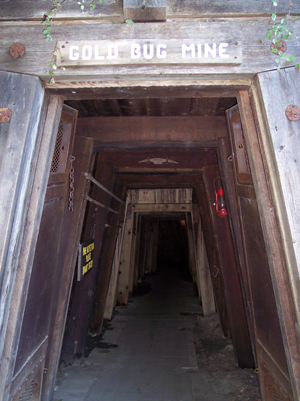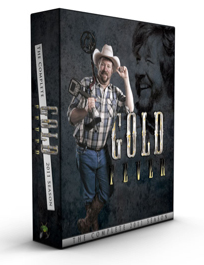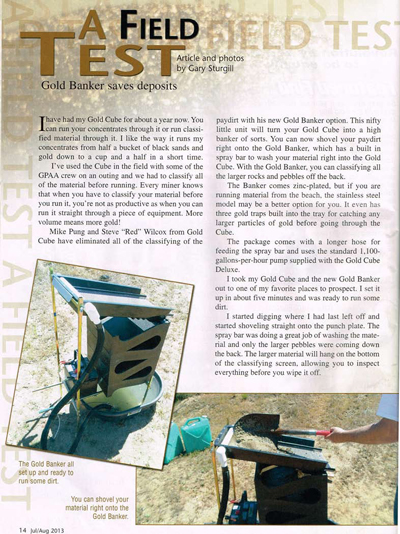Sunday, August 18 2013
The goal of Public Lands for the People (PLP) is to uphold constitutional and statutory rights related to the use of appropriated and unappropriated public lands by educating the public about their rights and laws that apply in their activities, and educating the government agencies in their application of those laws.
If, while you are out gold prospecting or mining, metal detecting, working your claim, or otherwise recreating, you are challenged by a respresentative of a governmental agency or by a public servant who wants you to stop doing what you are doing, it is recommended by PLP that you do the following: 1. Politely ask if you are breaking any laws. If you are told that you are breaking a law, then ask for an explanation of the law and any municipal code that may pertain to the law. 2. Do as you are asked by the government representative, then ask them for their name, badge number, position, and agency and district they represent. Record this info. in writing along with the date, time, and location you are in when this happened. 3. Please provide the info. you collect to PLP and they will advise you of the appropriate procedure to follow. 4. If you have a pleasant response from any of the representatives you come into contact with, such as they were being informative, cooperative, or helpful, PLP would like to know about it, too.
PLP is a 501(c)(3) Non-Profit Organization whose Mission Statement is: "TO REPRESENT AND ASSIST OUTDOOR USER GROUPS AND INDIVIDUALS INTERESTED IN KEEPING PUBLIC AND PRIVATE LANDS OPEN TO PROSPECTING, MINING, AND OUTDOOR RECREATION THROUGH PUBLIC EDUCATION, SCIENTIFIC DATA, AND LEGAL MEANS." For more information about the great work being done by Public Lands for the People, visit their website www.plp2.org Thursday, August 01 2013
Would you like a FREE box set of Gold Fever 2011 ($65 value) produced by Gold Prospectors Association of America? Make any purchase during the month of August, and your order could be randomly drawn at the end of the month to win the 7-disc box set packed full of your favorite Gold Fever moments from 2011. Join host Tom Massie as he travels the world in search of one of the planet’s most precious metals ... Gold! From his backyard in California to the glaciers of Greenland, this set contains 13 commercial-free episodes! Sunday, July 07 2013
Monday, July 01 2013
The Gold Cube is now shovel ready! Take the hassle out of pre-classifying and increase your yield at the same time! The Gold Banker was field tested by Gary Sturgill, Trade Show Manager for the Gold Prospectors Association of America (GPAA). His review appears on pages 14-15 in the July/August 2013 issue of Gold Prospector Magazine. Gary rated this new product 10 out of 10 for its easy for assembly, durability, and time savings. If you don't have a copy, here is what Gary had to say: "I have had my Gold Cube for about a year now. You can run your concentrates through it or run classified material through it. I like the way it runs my concentrates from half a bucket of black sands and gold down to a cup and a half in a short time. I've used the Cube in the field with some of the GPAA crew on an outing and we had to classify all of the material before running. Every miner knows that when you have to classify your material before you run it, you're not as productive as when you can run it straight through a piece of equipment. More volume means more gold! The Gold Banker eliminates the pre-classifying of the paydirt. This nifty little unit will turn your Gold Cube into a high banker of sorts. You can now shovel your paydirt right into the Gold Banker, which has a built in spray bar to wash your material right into the Gold Cube. With the Gold Banker, you can classify all the larger rocks and pebbles off the back. The Banker comes zinc-plated, but if you are running material from a saltwater beach, the stainless steel model may be your best option. It even has 3 gold traps built into the tray for catching any larger particles of gold before going though the Cube. The package comes with a longer hose for feeding the spray bar and uses the standard 1,100 gallons per hour pump supplied with the Gold Cube Deluxe. I took the Gold Cube and the new Gold Banker out to one of my favorite places to prospect and set it up in about 5 minutes and was ready to run some dirt. I started digging where I had last left off, and started shoveling straight onto the punch plate. The spray bar was doing a great job of washing the material and only the larger pebbles were coming down the back. The larger material will hang on the bottom of the classifying screen, allowing you to inspect everything before you wipe it off. Monday, June 10 2013
News Bulletin From Fisher Labs: This Wednesday evening, June 12, at 9:00 PM Central Time, the Travel Channel will be showing premier episodes of their new metal detecting reality show: Dig Wars. There will be two back-to-back 30 minute episodes about three pairs of detectorists that travel the country searching for artifacts, relics and coins. Three of the six hunters will use Teknetics and Fisher metal detectors and featured throughout the season will be the T2LTD, G2, F70, F75LTD and Gold Bug models. Mark your calendar and be sure to tune in to see Fisher and Teknetics metal detectors in action -- 9:00 PM Central and 8:00 PM Mountain (and re-aired 3 hours later). Wednesday, June 05 2013
Since gold is 19 times heavier than water, it will drop out of a moving current and settle into streambed gravels and other places whenever the water flow is no longer strong enough to keep it moving. Gold is also heavier by volume than the average weight of the sand, silt, and rocks that make up an average streambed. Because of the disparity in weight, when streambed material is being washed down a waterway, most of the gold will work down to the bottom of the streambed material. These "drop spots" are the best places to find gold.
Are there downed trees across the stream from winter storms? Check the gravels behind the obstruction. Tree roots and dense clumps of weeds along a stream bank can also trap gold, so check the dirt in these areas, too. Boulders are another natural gold trap, but be very careful when trying to move large rocks to check underneath them for gold. If you cannot move the boulders, sample around the base and in cracks and crevices. Natural "potholes" in rocks are excellent gold catchers. Debris can settle in the po holes and act as a "cap" for bits of gold that have been washed into the depression. Often the cap will completely hide gold that is underneath it, so check thoroughly. Another tip is don't be afraid to revisit waterways you've tested in the past, even if you think they're all worked out. Mother Nature changes rivers and streams every winter. The amount of snow melt and rain differs each year, which means "new" gold is always on the move... waiting for YOU to find it with your pan, sluice, highbanker, or dredge. Good luck, be safe, and have fun! Wednesday, April 03 2013
Weighing gold and gemstones can be a bit confusing. Miners use pennyweight and jewelers use grams. Gemstones are weighed in carats. The word "carat" comes from ancient India where carob seeds were used as small consistent weights. The word "pennyweight" comes from the old Gold Rush days when a miner would compare the weight of his gold dust against the weight of a penny. Keep in mind that a penny in 1849 was somewhat larger than it is today.
Pennyweight Conversions 1 pennyweight (dwt) = 7.776 carats 1 pennyweight (dwt) = 1.55 grams 31.1 grams = 1 troy ounce 1 pennyweight (dwt) = 24 grains 480 grains = 1 troy ounce 1 pennyweight (dwt) = 0.05 troy ounce 20 pennyweight (dwt) = 1 troy ounce 12 troy ounces = 1 troy pound Carat Conversions 1 carat = 0.20 grams 1 carat = 0.1287 pennyweight 1 carat = 0.0064 troy ounce 1 gram = 5 carats 1 pennyweight 7.776 carats 1 troy ounce = 155.5 carats Monday, March 04 2013
Once primarily used by landscapers and construction contractors, gold miners are now using Rock Crushers / Pulverizers to save time and get more gold. In most cases, you can take your rock crusher straight from the shipping container and use it in less than half an hour. No wasted time trying to find the right pulleys or chains because you get everything you need when you place an order. A rock crusher that has been designed and built by miners for miners can be an invaluable tool -- these tough machines are built well and rigorously tested in the field.
Whether you need a manual rock crusher or a power rock crusher (choose gas or electric), turn rock into talcum powder and get ALL the gold!  Monday, February 04 2013
The Gold Cube is now shovel ready! Take the hassle out of pre-classifying with this NEW Gold Banker (manufactured by Gold Cube). The 3/16th punch plate topper acts like a huge classifier. Already own a Gold Cube? Buy the top part only and then simply attach the stand extensions to your existing Cube stand and attach the 5 foot hose and you are ready to go for the gold!  The Gold Banker is constructed of thick ABS material with built in adjustable spray bar. The punch plate is anodized or stainless steel (your choice) that simply slides into the unit. Stainless is the best choice for salt water use, or just give the less expensive anodized version a good rinse with fresh water after use. Learn more about the Gold Banker. Monday, January 07 2013
Following the discovery of gold in Coloma, California on January 24, 1848, boomtowns sprang up quicker than weeds. Just eight miles away, Old Dry Diggins was one such tent-filled mining camp that took root. So named because miners had to move cartloads of dry soil to running water in order to separate out the gold, the population quickly swelled from hundreds of gold seekers to thousands. As to be expected, things got a little lawless and wild, and the name changed to Hangtown after numerous hangings took place in quick succession. Today, we know this historic gold rush town as Placerville, California.
 Most early prospectors got the gold by panning and sluicing. Gold was easier to see and easier to recover that way. Eventually, though, the “easy money” ran out and more and more small mining companies and individuals turned to hard rock mining. Take a self-guided walking tour of the Gold Bug Mine in Placerville’s Gold Bug Park, and you’ll see how these miners dug drifts (horizontal tunnels) into hillsides to follow the veins of quartz and gold.  The Gold Bug Mine (originally the Hattie Mine) is a typical hard rock mine found in the Mother Lode. If you haven’t had the opportunity to safely explore an underground mine, or want to introduce your kids to a little fun and history, Gold Bug Park is ideal. Not only can you can go underground, but you can visit a stamp mill and blacksmith shop, have a picnic, and do a little hiking, too. When you buy your tour ticket, you’ll get a hard hat to wear and a hand-held audio wand. As you make your way through the mine, the voice of an old-timer tells the tales of the Gold Bug and the California Gold Rush. Article continued here... |
|
Nugget of News Blog |








 Celebrate CHRISTMAS IN JULY! Not only do you get FREE SHIPPING on purchases of $350 or more, but now you will also get a FREE GIFT! Might be a how-to book, a treasure scoop, a keychain, a small bag of paydirt, or another cool item, so be prepared to be pleasantly surprised! Throughout the month of July only, just enter the word CHRISTMAS in the "Extra Information" field when placing your order of $350 or more, and you'll find a little something extra and FREE
Celebrate CHRISTMAS IN JULY! Not only do you get FREE SHIPPING on purchases of $350 or more, but now you will also get a FREE GIFT! Might be a how-to book, a treasure scoop, a keychain, a small bag of paydirt, or another cool item, so be prepared to be pleasantly surprised! Throughout the month of July only, just enter the word CHRISTMAS in the "Extra Information" field when placing your order of $350 or more, and you'll find a little something extra and FREE 